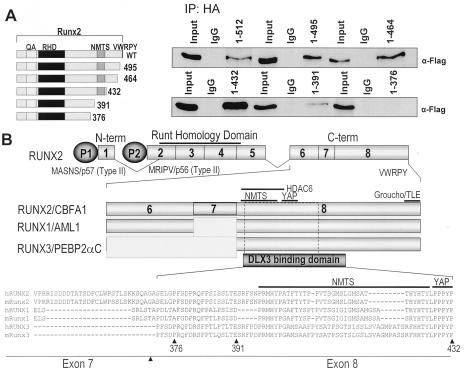FIG. 7.
Dlx3 interacts with a Runx2-specific domain in the C terminus. (A) The functional interacting domain of Runx2 was mapped by overexpression of HA-tagged Runx2 deletion mutants (shown on right) and Flag-tagged Dlx3 in ROS 17/2.8 cells. Coimmunoprecipitation was carried out using HA polyclonal antibody, and the interacting domain was characterized by Western blotting with anti-Flag antibody. The coimmunoprecipitation assays included normal immunoglobulins (IgG) from either rabbit (Dlx3) or mouse (Runx2), which were used as controls. Input represents 5% sample of the total cell lysate. (B) Illustration of the Runx2-Dlx3 interacting domain comparing the amino acid sequence among Runx family members of human and mouse origin. The top line shows the exon organization of mouse Runx2. The position of exons 6, 7, and 8 with respect to the interacting protein domain is also shown in the last line (arrows). The interacting domain (amino acids 376 to 432) includes the well-characterized nuclear matrix targeting signal and sequences essential for the Dlx3 interaction. The solid lines over Runx2 in the middle panel and over the sequence in the lower panel indicate the amino acids for each domain.

